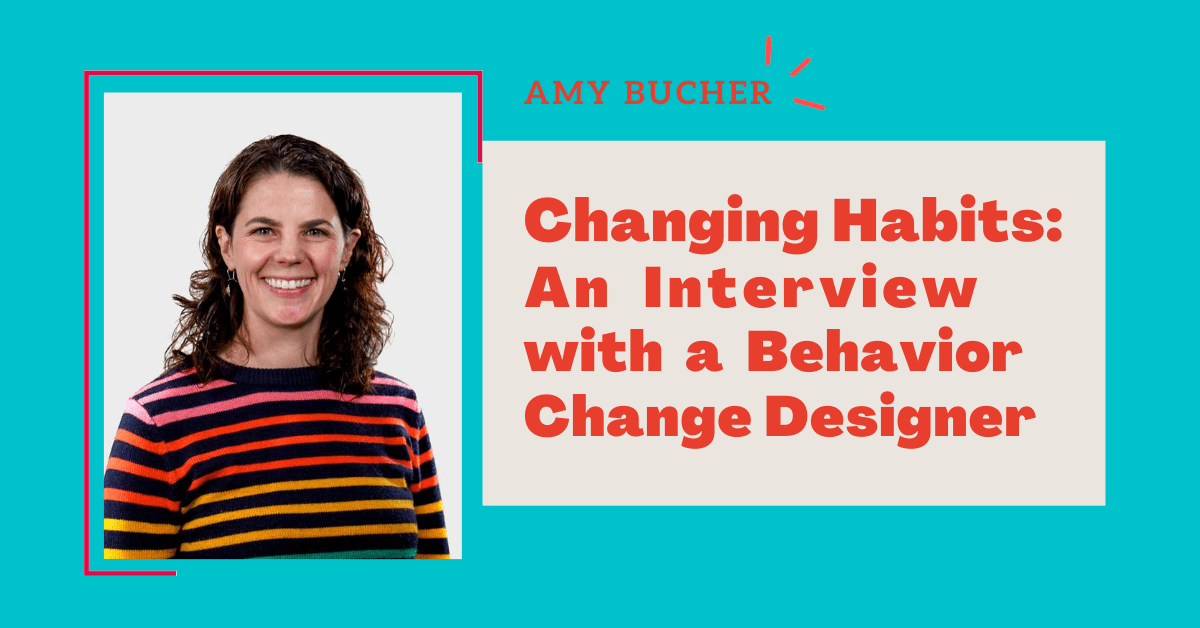Nir’s note: I recently caught up with Dr. Amy Bucher, the author of Engaged, a compelling guidebook on designing products and services that change people’s lives. She talks about behavioral design, the science of crafting products and services in such a way as to shape or influence human behavior. Here is our conversation.
Feel free to check out my other articles about habits, motivation and self-control.
Nir Eyal: Why did you write your book?
Amy Bucher: My profession of behavior change designer is still very new. We haven’t quite coalesced yet as a professional community, and there’s not a particularly well-defined path to entering the field. I was having more and more people reach out to me wanting to know how they could get involved in behavior change design. I’d do phone calls or coffees but the demand was outpacing my capacity, and I was also left feeling frustrated that there was no resource I could put in people’s hands to help them. That was the first big reason I wanted to write Engaged. It’s a love song to what I do and an invitation to others to join me.
The second big reason is that I love to read and write, and always wanted to write a book. I can remember writing in my diary as a little girl, “I will be a writer,” and underlining the “will.” My favorite thing to read is fiction and for better or worse I’m lousy at writing it, so at some point I realized my writing would be non-fiction. When I realized I’d gotten to a point in my career where I knew enough to write a book, it was a no-brainer to do it and fulfill that childhood dream.
NE: You’ve done some fascinating research. From what you’ve learned, what surprised you the most?
AB: I still learn something surprising with every single research study I do, but nothing will ever match the surprise that got me interested in psychology research in the first place. When I was an undergrad I became a research assistant on a series of projects looking at how subtle environmental cues influence people’s performance outside of their awareness. The idea that behavior could be shaped by something we don’t even notice blew my mind. It’s continued to be something that fascinates me across different areas of research, from how habits drive so much of our daily behaviors to how cognitive biases affect how we interpret information.
I am surprised that even though environmental changes are one of the most effective behavior change techniques, whether you’re talking about habits or motivation, self-control and other personal variables are still so prominent in how people think about achieving goals.
NE: What lessons should people take away from your book regarding how they should design their own behavior or the behavior of others?
NE: Writing a book is hard. What do you do when you find yourself distracted or going off track?
AB: Having worked from home in the past, I already had good practices in place like designating a specific area to work in my house and carving out times dedicated to writing. But the hard thing about writing a book is that it’s done on a computer, which means I can wander off track without much effort at all. That’s how I found myself wrestling with both book-related and non-book related distractions.
The non-book related distractions were easier to combat. These were things like checking social media or answering emails. I suspended my Facebook account for a while and that really helped me cut down on using it.

After reading Indistractible I also deleted a number of apps from my phone to reduce the temptation further and started explicitly telling my husband when I was writing so he’d know to give me clearance. I would also close browser tabs that regularly distracted me, like Gmail; if I could see I had unread emails in the tab header, it was too hard not to click. At some point I upgraded my operating system and the notifications on Outlook and my chat program stopped working; I simply didn’t address the issue and haven’t much missed them.
Book-related distractions were trickier. I often needed to look something up to make sure I was discussing it correctly in the manuscript. That meant venturing out into the web and having to be very cognizant when I started clicking away from relevant material. I also audited hundreds of apps and collected screenshots to use as examples, which introduced lots of opportunities to get distracted. At some point, my desire to not be working helped me to ignore some of those book-related intrusions.
NE: What’s one thing you believe that most people would disagree with?
AB: I don’t know about “most people,” but I’ve had enough disagree with me that I think it’s contentious. I don’t think we can impose a moral value on most behaviors people do. We have a tendency in our language and our business goals to consider certain things as right or good, like eating vegetables or getting exercise or taking medications the way a doctor tells you to.

After more than 15 years of doing research with people being asked to make these health changes, I firmly believe they need to want to do them if anything is going to stick. We can try to persuade people, or show them how these behaviors support other goals they have, but coercing them will not work in any sustained way. And I don’t think it makes someone a bad person if they prefer not to pursue these sorts of goals passed down from on high, even if they would contribute to objective improvements in some areas of their lives. The existing behaviors are clearly serving some purpose.
Another example is technology use. I know for you, and for me too, technology becomes a distraction from activities and people that we value more, and so cutting down on device use becomes a positive goal. I have to remind myself that some people derive pleasure from the technology in and of itself. It’s not necessarily wasting time to play a video game if that video game is making a person happy and is something they’re freely choosing to play. People have to raise their hands to say technology is a negative issue before it’s something they’ll work on changing.
The exception to being able to assign moral value to behaviors comes with anything that directly harms others. That gets us into edge cases—what if someone’s unwillingness to give up steak means their spouse will need to support their medical needs after a heart attack? What about the sustainability impacts of a meat-based diet? There’s a lively debate to be had there, and I do sometimes come down against personal autonomy. I’m glad people can’t smoke in restaurants anymore.
NR: What’s your most important good habit or routine?
AB: Probably running regularly. I got into running in my late twenties and it’s become a lifeline for me. I try to run between 20-30 miles per week and sign up for 1-2 half marathons per year. I struggle with it during the winter months (I live in Boston where it can get treacherous, plus I have severe Raynaud’s syndrome), but have found ways to cope. When I was unable to run for 6 weeks due to an injury a few years ago it became obvious how huge a role running plays in my ability to manage stress so now I prioritize it more.
That said, I don’t always feel like running so I’ve got a few mental tricks I use. When I’m traveling, I try to research good running routes so I don’t end up doing laps in parking lots, and then I think about the run as touring the new area by foot. I’ll also sign up for expensive treadmill speed workouts if I know I’m going to be pressed for time, because I’m sensitive to breaking commitments (and losing money). And connecting my Garmin watch to Strava means some of my friends can see when I run—I don’t want them to see me slacking.
NE: Are you working changing any bad habits?
AB: I have two big ones right now. One is that I don’t like to strength train, but I keep experiencing mild nagging injuries from running without balancing my muscles through deliberate exercise. I need to figure out how to work regular strength training into my routine.
The second is that I love food and drink. I really appreciate trying new cuisines, eating at restaurants, cooking and baking at home, having a nice bottle of wine, and so on. All of this is good in moderation but I’ve always struggled to find that right balance. I’ve made some headway by trying to be mindful about my choices. I’ll indulge on things I really love and try to savor them. It makes it easier to make healthier choices the rest of the time.
What one product or service has helped you build a healthy habit?
AB: I’ve really liked the Shapa scale, which is designed to get people into a habit of weighing themselves daily. Research shows that consistency in weigh-ins is a top predictor of weight maintenance, but like most people, I hated to do it because of the emotional reaction I’d have to the numbers. People’s weights naturally fluctuate a few pounds day to day for all kinds of reasons, but I’d see a small gain after a day of healthy choices and feel demoralized. The Shapa doesn’t have a display on the scale unit; you open an app while you stand on it, and then you get a color that lets you know if your weight is steady, rising, or declining. They use a z-score to factor out all the noise in your weight and only reflect significant changes.
It’s made a huge difference in my ability to be consistent about weighing myself. I’m approaching a 700 day streak . . . which leads to the other thing I love about my Shapa. It lets you go on vacation mode if you’ll be away from the scale. I travel a lot and it can interfere with consistency sometimes, so being able to still hit that streak makes me much more interested in getting right back on the scale when I’m home.
NE: What’s the most important takeaway you want people to remember after reading your book?
AB: I’d like to leave people with a sense of optimism and hope, that we can design products that are respectful of people while improving outcomes at scale. While I don’t think someone who fails to improve their health deserves judgment, I also recognize that the more people achieve healthy outcomes, the lower the costs to society and to loved ones. The magic is in the overlap of the Venn diagram between what people want and what benefits the collective. Behavior change can help find that overlap and design interventions to bring it to life.
Nir’s Note: If you this interview got you interested in behavioral design, you might also like these other posts:
- What Most People Don’t Know about Behavioral Design\ (interview)
- Designing for Behavior Change (book review)
- Behavior by Design (video)
Do you follow any other thought-leaders in behavioral design? Please share them in the comments below!
Related Articles
- Schedule Maker: a Google Sheet to Plan Your Week
- Habit Tracker Template in Google Sheets
- The Ultimate Core Values List: Your Guide to Personal Growth
- Timeboxing: Why It Works and How to Get Started in 2025
- An Illustrated Guide to the 4 Types of Liars
- Hyperbolic Discounting: Why You Make Terrible Life Choices
- Happiness Hack: This One Ritual Made Me Much Happier

